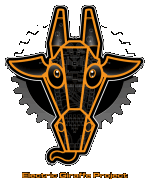The new sensor boards were completed in time for the 2011 Maker Faire:

This is the fourth iteration of the nose board, previous versions having been smashed by the lower jaw springing up into them. Each petting zone (nose, eyes, and new for this year: under the chin) now has a frosted polycarbonate guard on top of it. This serves three purposes: it provides a nice tactile surface for petting; it glows when lit by the new petting zone LEDs; and it protects the sensors from damage. Previously we had simply used blobs of glue to protect the sensors, but it was ugly. The new plates look great, are tough and durable, and also easy to remove if the circuit board needs to be accessed.
The new LEDs in the petting zones provide very helpful visual feedback. When multiple people are petting the giraffe at once it’s hard to know if your input is being registered or not because he’s busy responding to someone else’s input. With the LEDs you get immediate feedback that your input is doing something, even if he can’t respond to it immediately. There was some debate over how many petting zones there should be in the nose. Originally there were two, but last year Lindz expanded it to five. I argued to reduce it back to two because people just cannot see the difference – they are already at sensory overload in a fair environment before they even get to the giraffe, and they just don’t have the attention necessary to see details like that. We decided to go for two zones, and I tried to differentiate them as much as possible by clearly grouping them with a large distance between them, and providing tactile feedback in the form of a ridge between the two groups. Even so, most people would pet the whole nose at once and not try to trigger the two zones independently.
Something that came out of the faire is the need for an "interview mode" – a simple reactive mode that can be turned on during TV interviews to make sure he responds predictably and immediately while on camera.
The new status LEDs on the servo driver board were useful for keeping an eye on what he was doing, but it’s possible that they could be expanded even more, perhaps into an LCD with a readout of his status.

